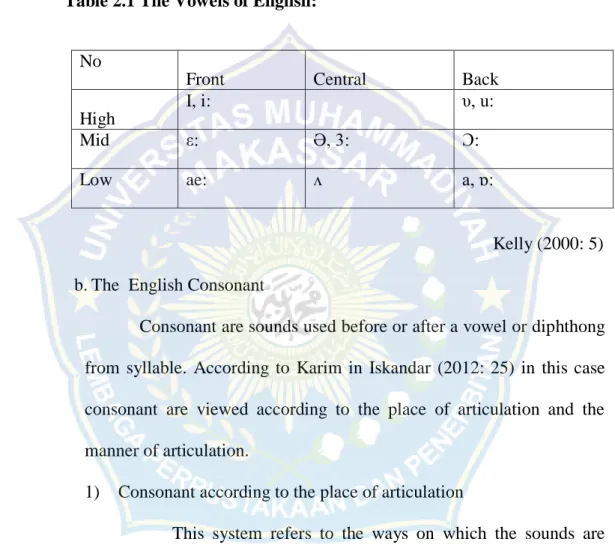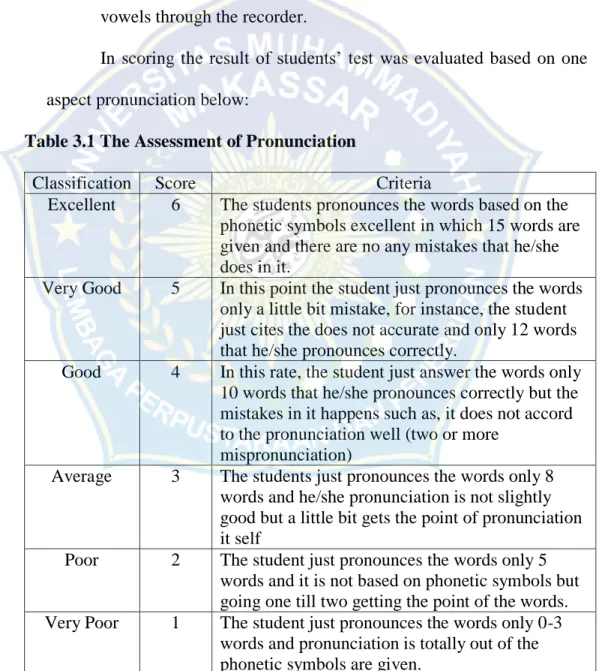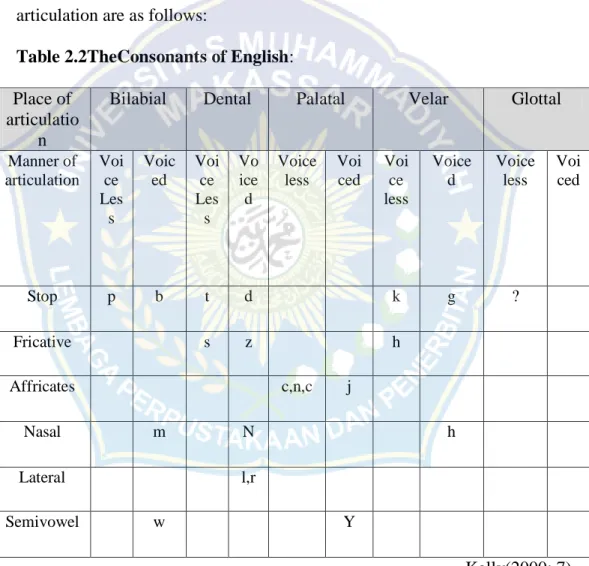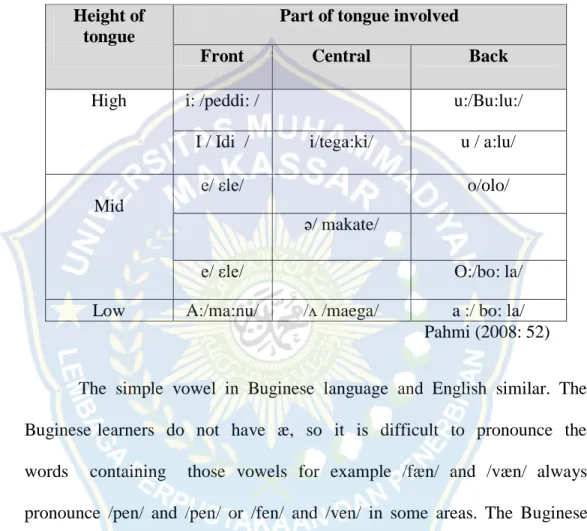My heartfelt thanks to all the lecturers at FKIP Unismuh, especially to the lecturers in the English department for their guidance during my studies. The instrument for the research was pronunciation test, and it is about reading test and recording. The result of this research showed that the Buginese students interfered in pronouncing English words. The results indicate that most of the students' low scores with an average score of 64.5.
According to Allen, pronunciation is one of the elements of the language that greatly contributes to better English speaking. For example, through analysis of the vowel sounds (analysis singer) and consonant sounds analysis (analysis consonants). Based on the above explanation, the researcher is interested in conducting a study entitled “The.

Research Problem
The Objective of Research
The Significance of Research
The Scope of Research
Chaira (2015) found that the research was focused on investigating the interlanguage errors that students made as a result of the intervention and finding solutions on how to avoid such interlanguage errors through methods that can be implemented by their teachers. Surianti (2013) found that interference occurs as a result of speech transport habits or native language dialect into a second language or dialect that also has knowledge of other languages. Based on the previous research findings above, the researcher concludes that the research problem on the researcher is different, but they all use segmental sounds.
So the researcher will try to conduct the research focused on the students in their sound patterns in English include the pronunciation of English phonemes especially English vowels.
The Interference
Among other things, the most important factors that can cause interference are the differences between the source language and the target language. Themselves arose as a result of the introduction or identification of speakers to certain elements of the source language, and then use it in the target language. According to Dulay defines interference as the automatic transfer, due to habit, of the surface structure of the first language to the surface of the target language.
From the above, the researcher concludes that the disorder may be the symptom that can cause the greatest changes in language.
Kinds of Interference
As students can also use an expansion on the first word, roomates expands the meaning of existing words so that the base word acquires a new word or even a combination of the above two possibilities. The pitch of the voice rises and falls at intervals to avoid pitch monotony in speech. The role of prosody in this textual function of information organization is essential, and for future teachers of English from another L1, a suitable treatment of the intonation system that.
It is believed that training metaphonological awareness of the relationship between patterns of thematic structure and prosody can help non-native speakers of English to self-regulate and refine their L2 innational choices in their delivery of the lecture genre.
Formal Language 1. Get the Lesson
The present paper will review some of the features of the prosodic configuration of thematic structure in readings in English and in River Plate Spanish, from the contributions of Systemic Functional Linguistics (SFL) and Discourse Intonation (DI), to possible cases of L1 interference to predict . The word 'mengerti' by adding the word 'in' is as morphological language interference. Sometimes they use the language or languages interference to re-explain and emphasize that language or meaning of the language or the speakers themselves do not understand the language when they use it, if they are bilingual or multilingual by Abdulhayi in Surianti (2013 : 12).
Such as the word 'objection' in the sentence speech by hernidah "Itula objection yang telah tehalan kepada kepada kita". The word 'menjudge' is an English word given 'men', so it is the intermingling of morphological. This is to further confirm from the word 'judgment' that all the attention to what was said by Asnah.
This is a phrase of interference phonology from the word 'day' where the word should be 'tidak'. Then the word 'mechanismnya' is from the word 'mechanism' which means 'arrangement' coupled with the suffix 'nya', the word 'nya' is a morphological language interference by Mahmud (2013: 11). The conversation is usually private about friends, discussion of another friend or gossip, news or information about the state of the Campus.
The word save comes from the English language support which means save or store but the word also occurs above the code saying "in" the word by itself I have no sense of the word but when it is connected with other words like "save" i' means it has the meaning of 'Her' in Buginese and a pronoun for the topics being discussed. The word 'mau' means 'wish' while 'ka' is a pronoun for the word 'I' in the Buginese support and it is a language variation of Buginese.
The Concepts of Pronunciation
The students' task is to judge which of the words the teacher is speaking. According to Crystal, vowels are phonetically sounds that are articulated without complete mouth closure or a degree of constriction that would cause audible friction, air escaping evenly across the middle of the tongue. Jackson states that vowels are sounds that result from various types of closure or obstruction of the passage of air through the mouth.
The /i/ vowel is pronounced by raising the front of the tongue high to the hard palate and the distance between the upper and lower jaws is small, the lips are spread and the tongue is tense. The whole body of the tongue is slightly retracted from the front position, the lips are spread. This vowel is pronounced by raising the front of the tongue: it is very light, to be named halfway between semi-open and open.
This vowel is pronounced by raising the back of the tongue high towards the soft palate. The /u/ vowel is pronounced by raising the portion of the back from position between semi-close and close. To pronounce this vowel, the front part of the tongue is raised, somewhat higher than for /o.
The back of the tongue is up: it is almost in the semi-open position. The most popular system is to place an apostrophe (‗) before the stressed syllable in the phonetic transcription of the word.

Buginese Phonemes
Consonants
Vowels
Conceptual Framework
Sample
Because the number of residents was too large, the researcher took 25% as the respondent of 200 students, so the total of the respondent was 20, the subject of the study was class XI IPA2 because they have low pronunciation ability in English phoneme.
Instrument for collecting data
The procedure of data collection
Interview is intended to find out additional information about the interference Buginese students in English phoneme pronunciation. Before an interview takes place, the interviewer must inform about the details of the study and provide assurance of ethical principles such as anonymity and confidentiality, giving respondents an idea of what to expect from the interview.
Data Analysis
In this study, after collecting the data from the students, the researcher carefully analyzed it. After the researcher gave the students the pronunciation test, she analyzed the most mispronunciations when pronouncing the vowels through the recorder. Very good 5 At this point, the student only mispronounces the words slightly, for example, the student quotes only the words that are incorrect and only 12 words that he/she pronounces correctly.
Very Poor 1 The student only pronounces the words. Only 0-3 words are given and the pronunciation is entirely out of phonetic symbols. This chapter consists of research findings and discussion containing data analysis in detail.

Findings
- Substitution of Phoneme
- The Percentage of Prominent Interference
- Discussion
- The Percentage of prominent Interference
The most prominent interference can be shown from the highest percentage of wrong pronunciation done by Buginese students. The table above shows that the percentage of correct pronunciation in central vowels (3:,Ә, ʌ) and front vowels (i:, I,e,æ) was generally lower than the percentage of incorrect pronunciation which may show that there is interference from Buginese are sounds, in this case the substitution of sounds. From those 6 vowels, we can see that /ae/ has the highest percentage of mispronunciation.
The percentage showed that the percentage shows that the percentage of incorrect pronunciation on the phoneme /ae/ 65%, and it is relatively high. The percentage of incorrect pronunciation is even much higher compared to the percentage of correct pronunciation: it is 5%. In vowels /u/, Students difficult to pronounce the vowels in back vowels of close rounded.
In fact, the percentage of incorrect pronunciation is much higher compared to the percentage of correct pronunciation: it is 70% and 30%. For vowels /e/, the students also find it difficult to pronounce, for example: pet, friends, the, then. The table shows that the percentage of incorrect pronunciation is also relatively higher than the correct pronunciation which is only 40%, while the incorrect pronunciation is 60%.
In vowels /a/, for example in the words: cat, rats, The percentage of incorrect pronunciation and the percentage of correct pronunciation 5% and 95%. Through the explanation above, the phoneme that has prominent interference was phoneme /ae/ with the interference percentage was 95%.
Conclusion
Suggestion
Teachers need to care about students' English pronunciation by showing them how to pronounce English sounds correctly and showing them how the correct pronunciation should be. Teachers should give students more pronunciation exercises as well as opportunities to pronounce English sounds, especially on central vowels (3:,Ə, ʌ) and front vowels (i:, I,e,æ). Beberapa Madhab and dichotomy Theory Linguistics. http://jurnal.ugm.ac.id/index.php/jurnal-humaniora/article/view/693) Celce.
Teaching Pronunciation: A Coursebook and Reference. http://lhyliees.blogspot.co.id/2013/04/interferensi-dan-integrasi-a.html). An analysis of students' error in pronouncing English vowels A case study of the eleventh grade of SMA Kartika Wirabuana XXI in the academic year 2014/2015). New York: Pergamon Press, Inc. http://pusatbahasaalazhar.wordpress.com/hakikat-hakiki- medekkede/interferensi-dan-integrasi/).
Improving Students' Year Students' English Pronunciation by CALD (Cambridge Advance Learner's Dictionary) Software (A Classroom Action Research on the Tenth Grade Students of SMA Nasional Makassar). Improving the second year students' English pronunciation by using number heads together strategy (NHT) at SMAN 1 Rilau Ale Bulukumba. The interference of Laporo sounds to students' English pronunciation (a descriptive research in the eleventh grade.
Eco. 2011. Improving students' pronunciation using English songs in the tenth grade of SMK Cyber Media.

